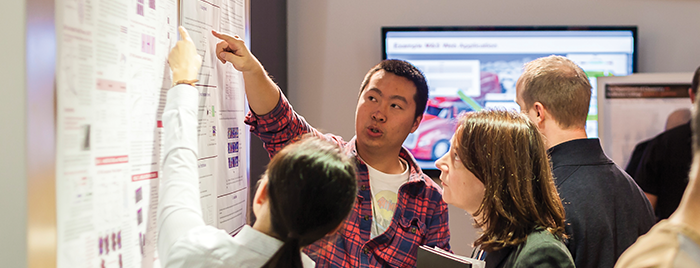A melting pot of eye-opening scientific research projects immersed attendees of the December 2015 Statewide Users Group (SUG) meeting at the Ohio Supercomputer Center (OSC). Research on topics—virtual welding simulation, evolutionary modeling and water absorption, just to name a few—were on full display during the Flash Talk and Poster competitions.
The general aims of SUG meetings is to highlight new scientific developments produced through the use of OSC resources, foster connections between OSC staff and SUG members, and gain feedback as to the future of OSC and its role in supporting science across Ohio. Since the first meeting of SUG in November 1986—almost a full year before the official 1987 establishment of OSC by the Ohio Board of Regents (now the Ohio Department of Higher Education)—Ohio research practitioner-advisors have provided OSC’s leadership with expert program and policy advice. To that end, SUG meets twice a year (October and April) to provide a forum for discussing issues, trends and developments in research and maintains several standing committees to consider vital issues.
The SUG Allocations Committee oversees a peer review grant process that allocates system resources to all academic users of the center. The Hardware and Operations Committee advises leadership on user needs and priorities for hardware configuration and acquisitions, as well as policy, procurement and operational issues. The Software and Activities Committee reviews software supported by the center for availability, clarity of documentation, quality of user interface, ease of use, logical development of the presentation, effectiveness, contribution to OSC resources and degree of restrictions.
In recent years, SUG meetings have featured well-attended poster and flash talk competitions.
“This format has reinvigorated SUG and the next challenge for us is to continue that growth,” said Brian Guilfoos, HPC client services manager at OSC. “I’m very happy with the turnout we’ve had and the exceptional number of people from around Ohio coming out to show what they’re using the services we provide.”
Guest speakers are also a regular aspect of SUG meetings. The December 2015 meeting featured two keynotes. Dr. Daniel Lacks, professor of Chemical Engineering at Case Western Reserve University, delivered a presentation titled “Solvophobicity,” in which he discussed what makes a surfactant effective when the solvent is not just water. Suzy Tichenor, director of the Industrial Partnerships Program at Oak Ridge National Laboratory, followed with a presentation titled, “Oak Ridge Leadership Computing Facility and Industry: Partnering for Success.”
SUG Executive Committee
Chair: Tom Beck, University of Cincinnati
Allocations Committee Chair: Christopher Hadad, The Ohio State University
Hardware Committee Chair: John Heimaster, The Ohio State University
Software Committee Chair: Rick Prairie, University of Cincinnati
Non-voting OSC Staff: David Hudak, Brian Guilfoos, Doug Johnson, Karen Tomko
December Poster Winner
Project Lead: Chris Ehemann, The Ohio State University
Research Title: Atomistic modeling of Ti-Nb alloys
Funding Source: The Ohio State University
Chris Ehemann, a graduate research associate within The Ohio State University’s Department of Physics, claimed first place in December’s poster competition for his work on a project that used OSC resources for atomistic modelling of niobium-titanium (Ti-Nb) alloys.
“Ti-Nb alloys have been found to exhibit bone-matching elastic properties and excellent biocompatibility, making them a promising material for biomedical implants,” Ehemann explained. “These alloys also form the basis for a new class of high-strength multi-purpose alloys called gum metals. We presented a molecular dynamics potential that captures the phase transformations and elastic properties of Ti-Nb alloys … involving both stress-induced and temperature-induced transformations.”
The research team Ehemann belongs to developed a Modified Embedded-Atom Method (MEAM) potential for the Ti-Nb system, fitted to first-principles data using a genetic algorithm. Accuracy of the MEAM potential was tested by predicting the measured elastic anisotropy and phase transformation dynamics. OSC’s computational resources to the project included Density Functional Theory (DFT) calculations performed with the Vienna Ab-initio Simulation Package with PAW-PBE pseudopotentials. Molecular dynamics simulations were performed using the LAMMPS package.
The research project was credited to Ehemann and Ohio State Professor John Wilkins, Ph.D.
December Flash Talk Winner
Project Lead: Aaron Wilson, The Ohio State University
Research Title: Improving the regional arctic system reanalysis with high performance computing
Funding Sources: The Ohio State University, the National Science Foundation, NASA, the National Center for Atmospheric Research
Aaron Wilson, a research associate within the Byrd Polar and Climate Research Center at The Ohio State University, was the flash talk winner for his presentation on Arctic System Reanalysis (ASR), a high-resolution regional assimilation of model output, observations and satellite data.
“What we’re attempting to do is create a regional reanalysis that’s really high resolution in space and time,” Wilson said. “It’s a blend of model observations to get a cohesive picture through space and time of the climate of the (arctic) region, and so we can take a model for the past and team that up with the observations and be able to look back and find out whether the climate changed over time.”
ASR has been refined to ASRv2, a far superior tool for analyzing Arctic climate change over the observation period of 2000-2012. Wilson leveraged the power of 2,048 cores of OSC systems for ASRv2 analysis.
Wilson was part of a research team that included David H. Bromwich, Lesheng Bai, Keith Hines, Sheng-Hung Wang, Ziquan Liu, Hui-Chuan Lin, Michael Barlage and Ying-Hwa Kuo.

